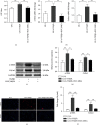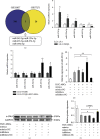Human Umbilical Cord Mesenchymal Stem Cells Ameliorate Hepatic Stellate Cell Activation and Liver Fibrosis by Upregulating MicroRNA-455-3p through Suppression of p21-Activated Kinase-2
- PMID: 33708992
- PMCID: PMC7932777
- DOI: 10.1155/2021/6685605
Human Umbilical Cord Mesenchymal Stem Cells Ameliorate Hepatic Stellate Cell Activation and Liver Fibrosis by Upregulating MicroRNA-455-3p through Suppression of p21-Activated Kinase-2
Abstract
Mesenchymal stem cells (MSCs) were shown to have potential therapeutic effects for treatment of liver fibrosis, and dysregulated expression of microRNAs (miRNAs) played a pivotal role in the pathogenesis of liver fibrosis by regulating their downstream target genes. However, the mechanism by which MSCs affect the progression of liver fibrosis by regulating miRNA expression remains unclear. Here, we investigated whether human umbilical cord MSCs (HUC-MSCs) attenuated hepatic fibrosis by regulating miR-455-3p and its target gene. Significantly upregulated miRNA (miR-455-3p) was screened out by GEO datasets analysis and coculture HUC-MSCs with hepatic stellate cell (HSC) LX-2 cells. p21-activated kinase-2 (PAK2) was forecasted to be the target gene of miR-455-3p by bioinformatics analyses and confirmed by luciferase reporter assay. HUC-MSCs were transplanted into mice with carbon tetrachloride- (CCl4-) induced liver fibrosis, the result showed that HUC-MSC transplantation significantly ameliorated the severity of CCl4-induced liver fibrosis, attenuated collagen deposition, improved liver function by reducing the expression of alanine aminotransferase (ALT) and aspartate aminotransferase (AST) in serum, upregulated miR-455-3p, and suppressed PAK2 expression of liver tissue in mice. Taken together, our study suggests that HUC-MSCs inhibit the activation of HSCs and mouse CCl4-induced liver fibrosis by upregulation of miR-455-3p through targeting PAK2.
Copyright © 2021 Qing Zhou et al.
Conflict of interest statement
The authors declare that they have no conflicts of interest.
Figures





Similar articles
-
Mesenchymal stem cells improve liver fibrosis and protect hepatocytes by promoting microRNA-148a-5p-mediated inhibition of Notch signaling pathway.Stem Cell Res Ther. 2022 Jul 26;13(1):354. doi: 10.1186/s13287-022-03030-8. Stem Cell Res Ther. 2022. PMID: 35883205 Free PMC article.
-
Human umbilical cord mesenchymal stem cells ameliorate liver fibrosis by inhibiting hepatocyte ferroptosis and macrophage polarization via the miR-455-3p/PLAU axis.Stem Cell Res Ther. 2025 Jul 30;16(1):412. doi: 10.1186/s13287-025-04526-9. Stem Cell Res Ther. 2025. PMID: 40739265 Free PMC article.
-
Human umbilical cord mesenchymal stem cells inhibit liver fibrosis via the microRNA-148a-5p/SLIT3 axis.Int Immunopharmacol. 2023 Dec;125(Pt A):111134. doi: 10.1016/j.intimp.2023.111134. Epub 2023 Oct 31. Int Immunopharmacol. 2023. PMID: 37918086
-
Research Progress on the Effect of Autophagy and Exosomes on Liver Fibrosis.Curr Stem Cell Res Ther. 2024;19(6):785-797. doi: 10.2174/1574888X18666230427112930. Curr Stem Cell Res Ther. 2024. PMID: 37102476 Review.
-
Mesenchymal stromal cells in hepatic fibrosis/cirrhosis: from pathogenesis to treatment.Cell Mol Immunol. 2023 Jun;20(6):583-599. doi: 10.1038/s41423-023-00983-5. Epub 2023 Feb 24. Cell Mol Immunol. 2023. PMID: 36823236 Free PMC article. Review.
Cited by
-
Mesenchymal stem cells improve liver fibrosis and protect hepatocytes by promoting microRNA-148a-5p-mediated inhibition of Notch signaling pathway.Stem Cell Res Ther. 2022 Jul 26;13(1):354. doi: 10.1186/s13287-022-03030-8. Stem Cell Res Ther. 2022. PMID: 35883205 Free PMC article.
-
Human umbilical cord mesenchymal stem cells ameliorate liver fibrosis by inhibiting hepatocyte ferroptosis and macrophage polarization via the miR-455-3p/PLAU axis.Stem Cell Res Ther. 2025 Jul 30;16(1):412. doi: 10.1186/s13287-025-04526-9. Stem Cell Res Ther. 2025. PMID: 40739265 Free PMC article.
-
Stem cells for treatment of liver fibrosis/cirrhosis: clinical progress and therapeutic potential.Stem Cell Res Ther. 2022 Jul 26;13(1):356. doi: 10.1186/s13287-022-03041-5. Stem Cell Res Ther. 2022. PMID: 35883127 Free PMC article. Review.
-
Applications of Mesenchymal Stem Cells in Liver Fibrosis: Novel Strategies, Mechanisms, and Clinical Practice.Stem Cells Int. 2021 Aug 10;2021:6546780. doi: 10.1155/2021/6546780. eCollection 2021. Stem Cells Int. 2021. PMID: 34434239 Free PMC article. Review.
-
P-21 Activated Kinases in Liver Disorders.Cancers (Basel). 2023 Jan 16;15(2):551. doi: 10.3390/cancers15020551. Cancers (Basel). 2023. PMID: 36672500 Free PMC article. Review.
References
MeSH terms
Substances
LinkOut - more resources
Full Text Sources
Other Literature Sources
Medical
Miscellaneous

